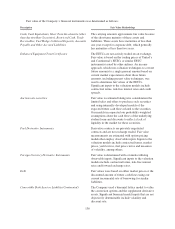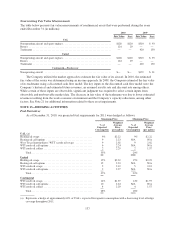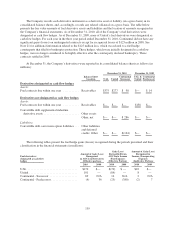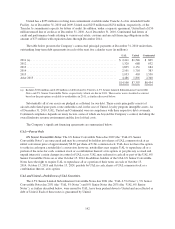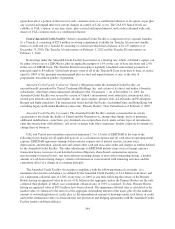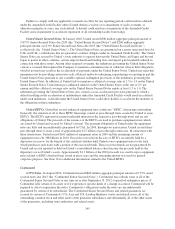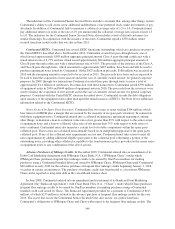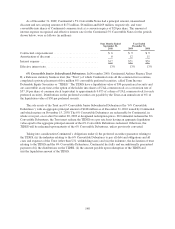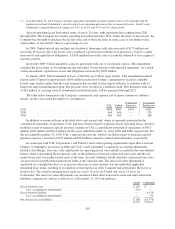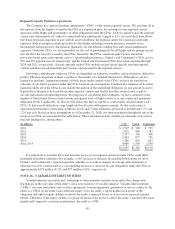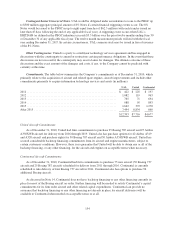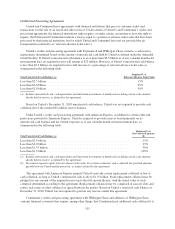United Airlines 2010 Annual Report Download - page 148
Download and view the complete annual report
Please find page 148 of the 2010 United Airlines annual report below. You can navigate through the pages in the report by either clicking on the pages listed below, or by using the keyword search tool below to find specific information within the annual report.The indenture for the Continental Senior Secured Notes includes covenants that, among other things, restrict
Continental’s ability to sell assets, incur additional indebtedness, issue preferred stock, make investments or pay
dividends. In addition, if Continental fails to maintain a collateral coverage ratio of 1.5 to 1.0, Continental must
pay additional interest on notes at the rate of 2% per annum until the collateral coverage ratio equals at least 1.5
to 1.0. The indenture for the Continental Senior Secured Notes also includes events of default customary for
similar financings. In conjunction with the issuance of the notes, Continental repaid a $350 million senior
secured term loan credit facility that was due in June 2011.
Continental EETCs. Continental has several EETC financings outstanding, which are similar in structure to
the United EETCs described above. In December 2010, Continental created two pass-through trusts, one of
which issued approximately $363 million aggregate principal amount Class A pass-through certificates with a
stated interest rate of 4.75% and one which issued approximately $64 million aggregate principal amount of
Class B pass-through certificates with a stated interest rate of 6.0%. The proceeds of the issuance of the Class A
and Class B pass-through trusts, which amounted to approximately $427 million, have been and will be used to
purchase equipment notes issued by Continental. Of the $427 million in proceeds, $188 million was received in
2010 and the remaining amount is expected to be received in 2011. The proceeds have been and are expected to
be used to fund the acquisition of new aircraft and in the case of currently owned aircraft, for general corporate
purposes. In 2009, through two transactions Continental created three pass through trusts to issue a total of
approximately $1.0 billion of certificates. In connection with these transactions, Continental issued $390 million
of equipment notes in 2009 and $644 million of equipment notes in 2010. The proceeds from the issuances were
used to finance the acquisition of new aircraft and in the case of currently owned aircraft, for general corporate
purposes. Consistent with the United EETC structure described above, Continental records the debt obligation
upon issuance of the equipment notes rather than upon the initial issuance of EETCs. See Note 16 for additional
information related to the Continental EETCs.
Notes Secured by Spare Parts Inventory. Continental has two series of notes totaling $304 million, which
bear interest at LIBOR plus a margin that are secured by the majority of its spare parts inventory. In connection
with these equipment notes, Continental entered into a collateral maintenance agreement requiring it, among
other things, to maintain a loan-to-collateral value ratio of not greater than 45% with respect to the senior series
of equipment notes and a loan-to-collateral value ratio of not greater than 75% with respect to both series of
notes combined. Continental must also maintain a certain level of rotable components within the spare parts
collateral pool. These ratios are calculated semi-annually based on an independent appraisal of the spare parts
collateral pool. If any of the collateral ratio requirements are not met, Continental must take action to meet all
ratio requirements by adding additional eligible spare parts to the collateral pool, redeeming a portion of the
outstanding notes, providing other collateral acceptable to the bond insurance policy provider for the senior series
of equipment notes or any combination of the above actions.
Advance Purchases of Mileage Credits. In December 2009, Continental entered into an amendment of its
Debit Card Marketing Agreement with JPMorgan Chase Bank, N.A. (“JPMorgan Chase”) under which
JPMorgan Chase purchases frequent flyer mileage credits to be earned by One Pass members for making
purchases using a Continental branded debit card issued by JPMorgan Chase. JPMorgan Chase paid Continental
$40 million in early 2010 for the advance purchase of frequent flyer mileage credits beginning January 1, 2016,
or earlier in certain circumstances. The purchase of mileage credits has been treated as a loan from JPMorgan
Chase and is reported as long-term debt in the consolidated balance sheet.
In June 2008, Continental entered into an amendment and restatement of its Bankcard Joint Marketing
Agreement (the “Bankcard Agreement”) with Chase Bank USA, N.A. (“Chase”), under which Chase purchases
frequent flyer mileage credits to be earned by OnePass members for making purchases using a Continental
branded credit card issued by Chase. The Bankcard Agreement provided for a payment to Continental of $413
million, of which $235 million is related to the advance purchase of frequent flyer mileage credits for the year
2016. The assets that secure the Continental Senior Secured Notes also secure, on a junior lien basis,
Continental’s obligations to JPMorgan Chase and Chase with respect to the frequent flyer mileage credits. The
146


